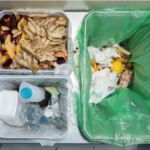So you’ve learned all about low waste and composting, and you’re ready to start your journey. But where do you start? It can seem a bit overwhelming at first. We recommend doing a quick audit of all the things you throw away, to give you a great jumping-off place for what areas are the best places to start reducing your waste.
What is a trash audit?
A trash audit, inspired by Going Zero Waste, is where you gather all the trash you have and evaluate what’s in it. This will give you a great picture of what types of things you’re throwing away.
Why should I do it?
It can be really difficult to figure out where to start and what items to swap out when you have no idea how much of everything you’re throwing away. Plus, the things you throw away the most will be the perfect place to start in making a big impact in your waste reduction. Not to mention, this can be a really fun activity to get your kids involved in the low waste lifestyle, too!
If you’re ready, we’ve got step-by-step instructions for you to easily do a quick trash audit and get started on your low waste journey.
How to do a Trash Audit

-
Dump out the bags and start organizing.
(This could get a little messy, so we recommend doing it outside or on a tarp of some kind.) Put on your globes and dump out each bag (make sure to keep your recycling separate). Start to organize it by what it is. (For food scraps, just keep that all together in one pile! No need to specify a banana peel vs an apple core.)
-
Tally it up.
Once you’ve organized your piles, use your paper and pen to write add tally marks for each item that repeats itself. For example, each milk carton in the trash will get it’s own tally. For food scraps, just tally each time you see a food scrap (or a group of food scraps, like peels from a carrot). Get as specific as you can, but if you have a lot of small things you can try your best to group them together.
-
Calculate.
Now that you’ve got your numbers for each category, you’ve got a pretty great picture of what you’re throwing away/recycling. Now you’ll want to do some quick math to figure out how much waste you could possibly be diverting if you started composting. To do this, first you’ll want to add up all the total tallies for each category. Then, grab your handy dandy calculator and plug in this quick equation: total number of food scraps divided by total of all trash. Now multiply that by 100, and bam! You’ve got your percentage of how much of your trash would be diverted by composting. If you want to learn more about composting, check out our guide here.
-
Evaluate the rest of the list.
Now your diverting percentage may be great, but what about the rest of the trash? This is a great place to start to evaluate what are the types of things you’re throwing away on a regular basis.
Go through the list, and start with the biggest offenders. For example, let’s say you had 20 paper towels. Start here and ask yourself: “Is there a reusable option I can use instead to cut back/eliminate my use of this product? Do I need it at all?” And this will give you a great starting place to find alternative swaps and start phasing out things you don’t need. Check out our complete guide to low waste products and swaps here.
And don’t forget to do this same thing with your recycling. While recycling may be slightly better than putting something in a landfill, it’s still better if we can completely divert our recycling as well.
Ready to get composting? Commit to Compost now and for a donation, you can get our exclusive Earth Day Everyday Countertop Compost Bin.

